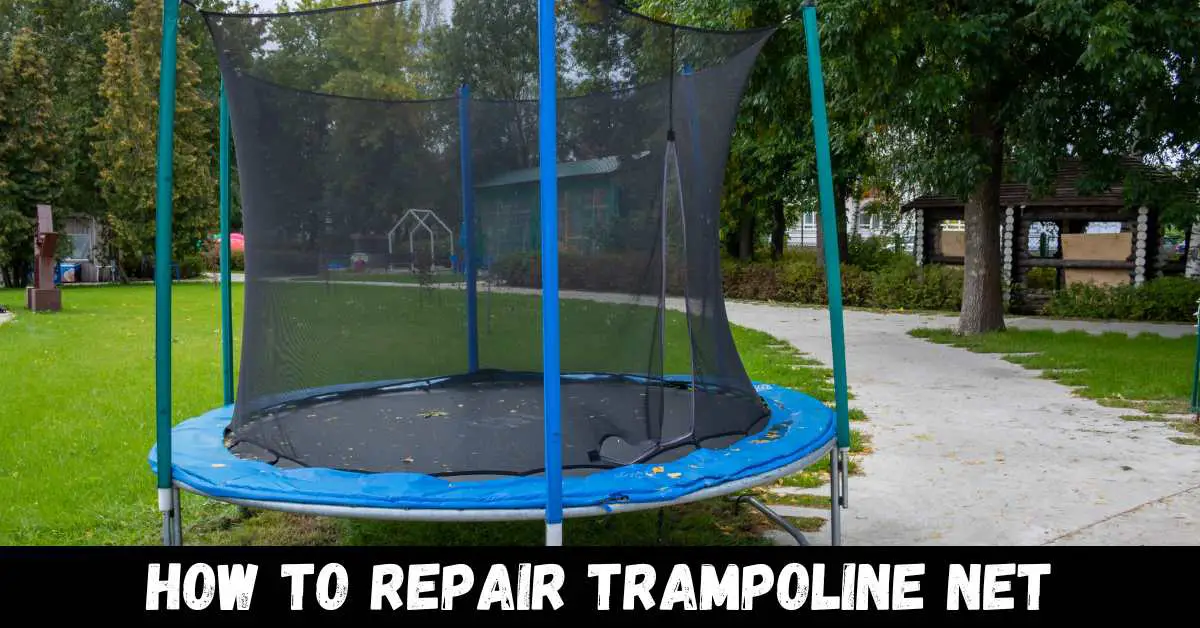Trampolines are a popular source of entertainment for both kids and adults, but with frequent use comes wear and tear, especially on the trampoline net. A damaged net can compromise the safety of those using the trampoline and should be repaired as soon as possible.
Repairing a trampoline net may seem like a daunting task, but it can be done with a little bit of effort and the right tools. Depending on the severity of the damage, the repair can range from a simple fix to a complete replacement of the net.
In this guide, we will explore different methods to repair trampoline nets. We will provide you with step-by-step instructions on how to identify the damage, choose the appropriate repair method, and implement it effectively.
By the end of this guide, you will have the knowledge and confidence to repair your trampoline net, ensuring that it is safe for anyone to use.
How to repair trampoline net: A damaged trampoline net can be a safety hazard. Repairing it is easy with a few simple steps. Identify the damage, such as a small hole or frayed edges. Then, use a needle and thread to sew up the hole and trim any loose threads to prevent further damage. If the damage is significant, replace the entire net by measuring the trampoline and ordering a new one.
Causes of a Broken Trampoline Net
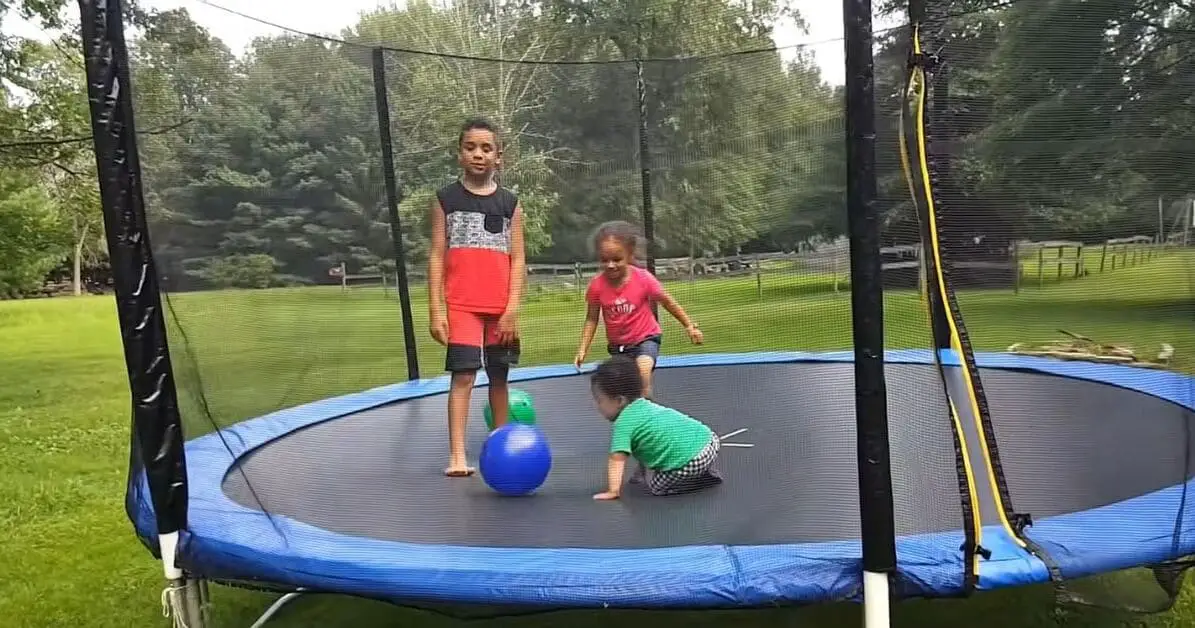
Trampolines are a fun way to get exercise and enjoy the outdoors, but over time, they can become damaged and require repairs. One of the most common issues trampoline owners face is a broken safety net.
A trampoline safety net serves a vital function in protecting jumpers from falling off the trampoline and onto the ground. When the safety net becomes damaged, it can compromise the safety of the trampoline and its users.
There are several reasons why a trampoline net might rip or tear. Understanding the source of the problem can help prevent future damage and ensure the safety of the trampoline’s users. Here are some of the common causes of a broken trampoline net:
Age and Wear and Tear
Over time, the trampoline net can become worn out and deteriorate, especially if it is exposed to harsh weather conditions such as intense sunlight, rain, and wind. Age and wear and tear can weaken the net’s material, making it more susceptible to rips and tears.
Exposure to Harsh Weather Conditions
As previously mentioned, exposure to harsh weather conditions such as intense sunlight, rain, and wind can weaken the net’s material and lead to damage. Prolonged exposure to the elements can cause the net to become brittle and prone to tearing.
Poor Quality Material
Trampoline nets made of low-quality material are more likely to become damaged. Investing in a high-quality trampoline net made of sturdy and durable material can help prevent tears and ensure the longevity of the net.
Misuse
Using the trampoline incorrectly can also cause damage to the net. For example, jumping on the net, sitting on the net, or hanging onto the net while jumping can all lead to tears and damage.
Improper Installation
If the trampoline net is not installed correctly, it can cause stress on the material and lead to tearing. It’s essential to follow the manufacturer’s instructions when installing the net to ensure it is properly secured and not under tension.
Sharp Objects
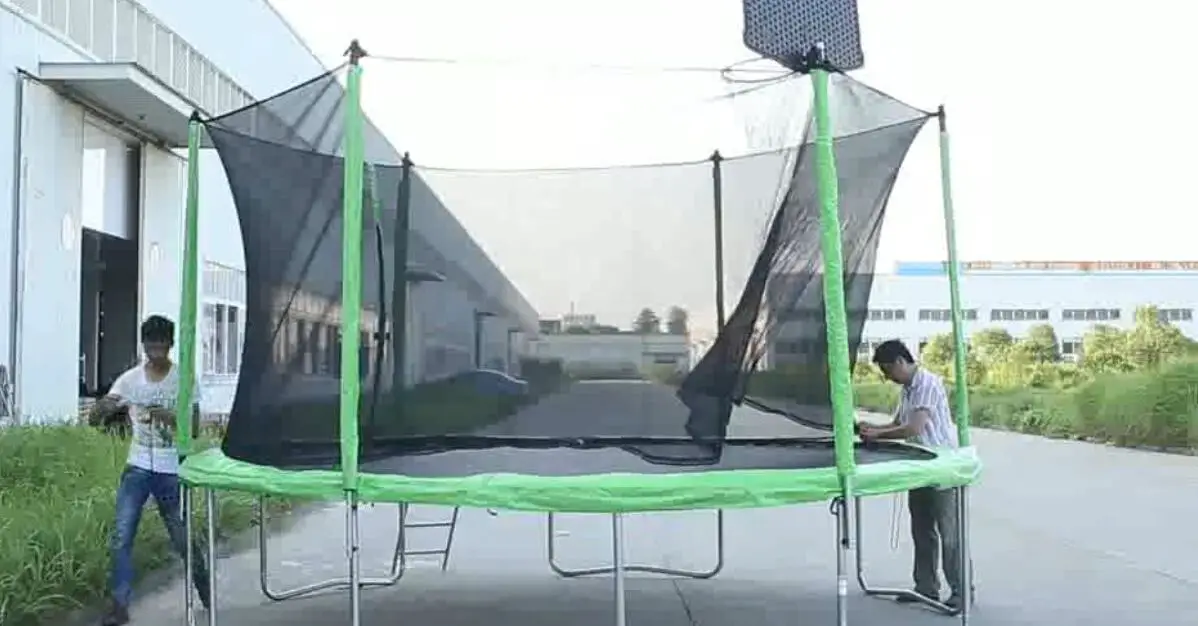
Sharp objects around the trampoline, such as sticks, rocks, or other debris, can puncture the net and cause damage. It’s essential to ensure the area around the trampoline is clear of any debris that could cause harm.
Understanding the causes of a broken trampoline net can help prevent future damage and ensure the safety of trampoline users.
Regularly inspecting the net for wear and tear, investing in high-quality material, using the trampoline correctly, and properly installing the net can all help prolong its lifespan.
Additionally, it’s essential to keep the area around the trampoline clear of any sharp objects that could puncture the net. By taking these preventative measures, trampoline owners can enjoy their trampoline safely for years to come.
Tools Needed for Trampoline Net Repair
A trampoline is a fun and exciting way to get some exercise and enjoy the outdoors, but over time, it may become damaged and require repairs. One of the most common issues that trampoline owners face is a broken safety net.
A damaged safety net can compromise the safety of the trampoline’s users, making it essential to repair the net as soon as possible. Fortunately, repairing a trampoline net is a relatively easy process, and with the right tools and materials, anyone can do it.
Here’s a list of necessary tools and materials for fixing a trampoline net:
Replacement Netting Material
The first thing you’ll need to repair a trampoline net is replacement netting material. Make sure you purchase netting material that is designed specifically for trampolines, as other materials may not be strong enough to withstand the wear and tear of jumping.
Scissors or a Utility Knife
You’ll need a good pair of scissors or a utility knife to cut the replacement netting material to the appropriate size. A sharp blade will make the job easier and ensure clean cuts.
Measuring Tape
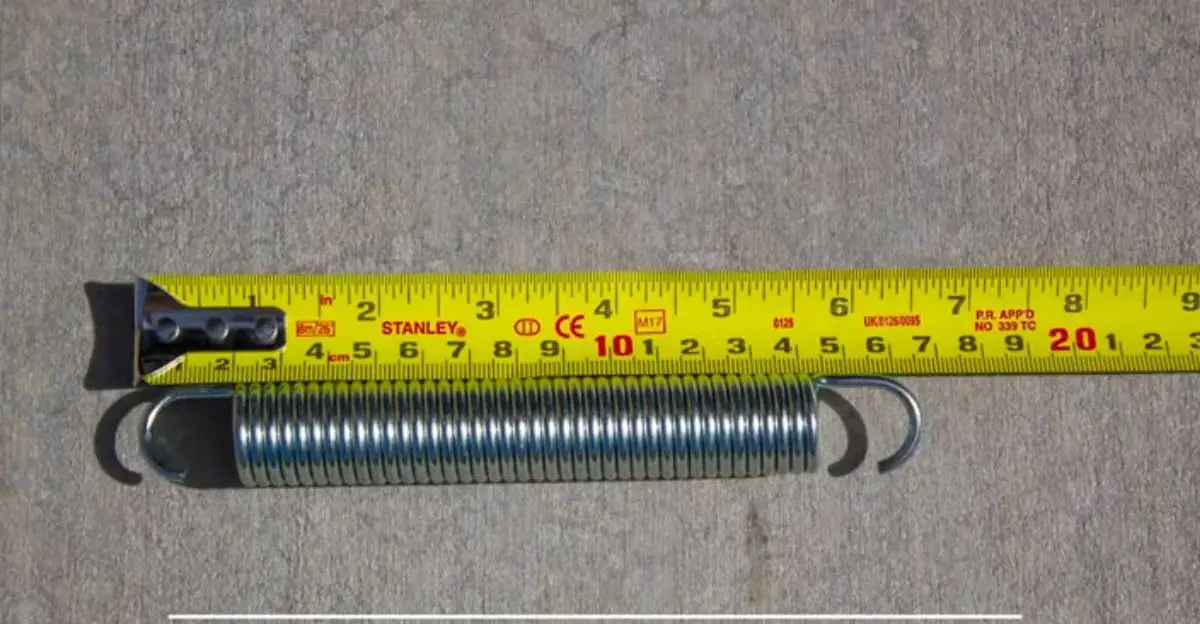
To ensure that the replacement netting material is the correct size, you’ll need a measuring tape to measure the length and width of the damaged area of the net.
Heavy Duty Thread
You’ll need a heavy-duty thread to sew the replacement netting material onto the trampoline. Make sure to choose a thread that is strong enough to withstand the weight of jumpers and the stress of jumping.
Sewing Needles
You’ll also need a set of sewing needles to stitch the replacement netting material onto the trampoline. Choose needles that are strong and durable, and ensure that they are the correct size for the thread you are using.
Spring Tool
If your trampoline has springs that need to be removed to repair the net, a spring tool can make the job much easier. A spring tool will help you remove the springs without damaging them or the trampoline frame.
Pliers
You may also need pliers to remove or adjust the springs if a spring tool is not available. Choose pliers with a sturdy grip to ensure that you can safely manipulate the springs.
When it comes to purchasing the tools and materials needed for trampoline net repair, there are several options. Many sporting goods stores carry replacement netting material, heavy-duty thread, sewing needles, and spring tools.
Online retailers such as Amazon and eBay also offer a wide selection of trampoline repair tools and materials.
In addition, some trampoline manufacturers may sell replacement parts and repair kits, including the tools and materials needed to repair a trampoline net. It’s always a good idea to check with the manufacturer first to see if they offer any repair solutions.
Repairing a trampoline net may seem like a daunting task, but with the right tools and materials, anyone can do it. By following these tips and purchasing the necessary tools and materials, you can repair your trampoline net and ensure the safety of its users for years to come.
How To Repair Trampoline Net?
Trampolines are a fun and popular activity for kids and adults alike. However, they do require some maintenance to ensure they remain safe and enjoyable to use. One common issue that trampoline owners face is a torn or broken net.
Fortunately, with a few tools and some basic sewing skills, repairing a trampoline net can be a simple and cost-effective solution. We’ll provide a step-by-step guide on how to fix a broken trampoline net.
Step 1: Measure the netting
The first step in repairing a trampoline net is to measure the netting. This will help you determine how much new netting you’ll need to purchase.
Measure the height and width of the trampoline frame to get the correct dimensions for the netting. Add a few extra inches to each side to allow for sewing.
Step 2: Remove the old netting
Using a pair of scissors, carefully remove the old netting from the trampoline frame. Be sure to remove all of the old netting and any attachments, such as hooks or straps.
Step 3: Cut the new netting
Using the measurements you took in Step 1, cut the new netting to the correct size. Use a sharp pair of scissors to ensure clean cuts.
Step 4: Attach the new netting
Start by attaching the new netting to the trampoline frame. This is typically done using straps or hooks that come with the trampoline. Be sure to follow the manufacturer’s instructions for attaching the netting. Once the netting is attached to the frame, you can begin sewing it together.
Step 5: Sew the netting together
Using a heavy-duty needle and thread, sew the netting together. Start at one end and work your way to the other end. Be sure to sew the netting securely, as it will need to withstand the weight of jumpers. Use a double stitch to reinforce the seams.
Step 6: Reinforce the corners
The corners of the netting are the most vulnerable areas and are prone to tearing. To reinforce the corners, sew on an extra layer of netting or use a patch. This will help prevent future tears and prolong the life of the netting.
Step 7: Test the netting
Once the netting is sewn together and reinforced, test it to make sure it’s secure. Push on the netting to ensure that it’s tightly attached to the frame and that there are no gaps or weak spots. If everything looks good, your trampoline is ready to use.
How to Know When to Fix Your Trampoline Net
Trampolines are a fun way to exercise and spend time with family and friends, but it’s important to keep them in good condition to prevent injuries. One essential component of a trampoline is the net, which keeps the user safe while jumping.
Over time, trampoline nets can wear out, tear, or become damaged, making it important to know when to fix or replace them. Here are some signs to look for to know when it’s time to repair your trampoline net.
Visible Tears or Holes
The most obvious sign that it’s time to fix your trampoline net is visible tears or holes in the netting. Even small tears can lead to larger ones over time, and they compromise the safety of the trampoline.
If you notice any tears or holes in your trampoline net, it’s essential to repair them as soon as possible.
Worn or Frayed Edges
Another sign that your trampoline net needs repair is worn or frayed edges. Over time, the edges of the netting can become damaged from rubbing against the metal frame of the trampoline or from exposure to the elements.
If you notice any frayed edges or worn spots on your net, it’s time to repair or replace it.
Loose or Sagging Netting
If your trampoline net is loose or sagging, it’s a sign that it needs to be repaired or replaced. A loose net can be dangerous, as it can lead to falls or other injuries.
To check if your net is loose, stand inside the trampoline and push on the netting. If it moves more than a few inches, it’s time for a repair.
Fading or Discoloration
While not a safety concern, fading or discoloration of the netting can be a sign that it needs to be replaced. Over time, exposure to the sun can cause the netting to fade or become discolored, making it look unsightly.
If you’re concerned about the appearance of your trampoline net, it’s time for a replacement.
Age
Finally, it’s important to consider the age of your trampoline net when deciding whether to repair or replace it. Most trampoline nets are designed to last for several years, but factors such as exposure to the sun, weather conditions, and frequency of use can all impact their lifespan.
If your net is more than a few years old, it’s worth considering whether it’s time for a replacement.
Other Trampoline Repairs and Maintenance Tips
Trampolines are a fun way to stay active and enjoy the outdoors. However, over time, the trampoline and its components can experience wear and tear, which may result in safety hazards. It is essential to regularly maintain and inspect your trampoline to ensure that it remains safe for use.
Here are some other trampoline repairs and maintenance tips:
Maintaining the Trampoline Mat
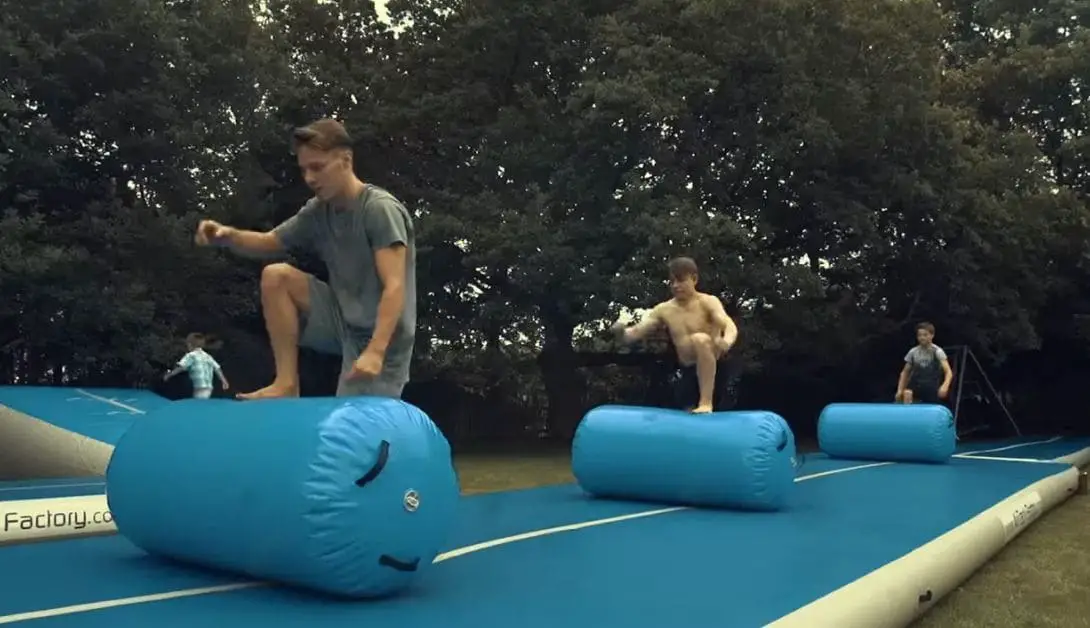
The trampoline mat is a crucial component of the trampoline, and it’s essential to maintain it properly. It is recommended to regularly clean the mat with a mild soap and water solution. Avoid using harsh chemicals that can damage the mat’s material.
It’s also essential to remove any debris, such as leaves or sticks, from the mat as they can damage the surface and lead to tears or holes.
Checking the Springs
The springs are responsible for the trampoline’s bounce, and it’s essential to regularly check them for wear and tear. Ensure that all the springs are intact, properly tensioned, and free of rust. If any springs appear worn or damaged, it’s time to replace them.
Maintaining the Trampoline Frame
The trampoline frame is the backbone of the trampoline and must be regularly checked for rust or other damage.
Make sure to inspect the frame for any cracks or damage that could lead to an unsafe situation. It’s recommended to apply a rust-resistant spray or paint to the frame annually to prevent rust.
Fixing Sagging Safety Nets
Over time, the safety netting of your trampoline may begin to sag or become loose. To fix this issue, you’ll need to adjust the tension of the safety netting. Start by checking that the safety netting is attached correctly to the frame.
Then, adjust the tension of the safety netting by tightening the straps or adjusting the hooks to ensure that the netting is taut.
Fixing Torn Mesh
If the mesh of your trampoline has been torn, it’s essential to repair it immediately. A torn mesh can result in a safety hazard, as it can lead to falls or injuries. To fix a torn mesh, you’ll need to sew it together using a heavy-duty nylon thread.
Start by removing any loose threads or debris from the torn area. Then, sew the torn area together using a whip stitch, ensuring that the thread passes through both sides of the mesh.
Protecting Your Trampoline
One of the best ways to prevent future damage to your trampoline is to protect it from the elements. If you live in an area with harsh weather conditions, it’s essential to store your trampoline indoors or cover it with a weather-resistant cover.
This will help protect the trampoline from the sun, wind, and rain, which can all damage its components.
Buying a New Trampoline: What to Look for
When it comes to purchasing a new trampoline, there are several factors to consider to ensure you’re getting the best value for your money. Whether you’re replacing an old trampoline or buying one for the first time, taking the time to research and compare different options can help you make an informed decision.
we’ll discuss some of the most important factors to consider when shopping for a new trampoline, as well as provide some recommendations for high-quality trampoline brands.
Size and Weight Limit
One of the first things you should consider when shopping for a new trampoline is the size and weight limit.
Trampolines come in a variety of sizes, from small 8-foot models to large 15-foot models, and it’s important to choose one that will fit your available space and meet your family’s needs. Additionally, you’ll want to check the weight limit of the trampoline to ensure it can safely accommodate all users.
Frame and Springs
The frame and springs of a trampoline are critical components that determine the stability and bounce of the trampoline. Look for a trampoline with a sturdy, rust-resistant frame made from galvanized steel or aluminum.
Springs should also be made from durable materials that won’t rust or deteriorate over time, such as galvanized steel or zinc-plated steel.
Safety Features
Safety should be a top priority when purchasing a trampoline, especially if you have children who will be using it. Look for a trampoline with safety features such as a safety net enclosure, padding on the frame and springs, and a sturdy ladder for easy access.
It’s also important to follow all safety guidelines and recommendations, such as limiting the number of users at one time and not allowing users to perform dangerous stunts.
Brand Reputation and Reviews
When shopping for a trampoline, it’s important to choose a reputable brand with a history of producing high-quality products. Look for brands that have positive reviews and a strong reputation for safety and durability.
You can also check online reviews from other customers to see what they have to say about the trampoline’s performance and reliability.
Price
Trampolines come in a range of prices, from budget-friendly models to high-end options with advanced features. Consider your budget and how much you’re willing to spend on a trampoline, keeping in mind that a higher price tag may come with added safety features and durability.
Recommended Trampoline Brands
Here are some of the top trampoline brands recommended by experts:
Skywalker Trampolines: This brand is known for producing high-quality trampolines with excellent safety features, including safety nets and padded frames.
Springfree Trampoline: Springfree trampolines use a unique design that eliminates the need for traditional springs, making them safer for users. They also come with safety nets and other safety features.
Vuly Trampolines: Vuly trampolines are known for their innovative designs and durable construction. They come with safety nets and other safety features, as well as advanced features such as built-in speakers and LED lights.
JumpSport Trampolines: JumpSport trampolines are known for their safety and durability, with features such as safety nets and padded frames. They also offer a range of sizes and options to fit different budgets.
Zupapa Trampolines: Zupapa trampolines are known for their sturdy construction and safety features, including safety nets and padded frames. They also offer a range of sizes and options to fit different budgets.
FAQs About How To Repair Trampoline Net
Q.1 What are the common issues that can arise with a trampoline net?
Over time, trampoline nets can get worn out, develop holes, or become loose, which can compromise the safety of the trampoline.
Q.2 Can a trampoline net be repaired?
Yes, a trampoline net can be repaired if the damage is minor. However, if the damage is significant, it may be better to replace the net entirely.
Q.3 What materials are needed to repair a trampoline net?
You will need a needle and thread, patching material, scissors, and zip ties or bungee cords.
Q.4 How do I fix a hole in a mesh trampoline?
To fix a hole, sew the edges of the hole together using a needle and thread. If the hole is too big, patch it with a piece of patching material and sew it onto the net.
Q.5 How do I secure the bottom of a trampoline net?
Use zip ties or bungee cords to secure the bottom of the net to the trampoline frame.
Q.6 How do I take the top off a trampoline net?
Most trampoline nets have clips that attach the net to the poles. Unclip the clips to remove the top of the net.
Q.7 Is it safe to use a trampoline without the net?
No, it is not safe to use a trampoline without a net. The net provides a safety barrier to prevent users from falling off the trampoline and getting injured.
Conclusion
In conclusion, repairing a trampoline net is a straightforward process that can be done with a few tools and a bit of effort. Identifying the damage, choosing the appropriate repair method, and implementing it effectively are key to ensuring the safety of those using the trampoline. It’s essential to know when to fix the trampoline net to avoid potential accidents.
Additionally, regular trampoline maintenance and repairs, such as replacing worn-out springs or padding, can prolong the life of the trampoline and ensure that it continues to be safe for use.
If you’re looking to buy a new trampoline, it’s important to consider factors such as size, weight limit, and durability to make an informed decision. With these tips and tricks, you can repair your trampoline net and enjoy safe and fun jumping experiences.
We hope this guide on How To Repair Trampoline Net has been helpful to you. If you have any questions, please feel free to ask them in the comments section below.

